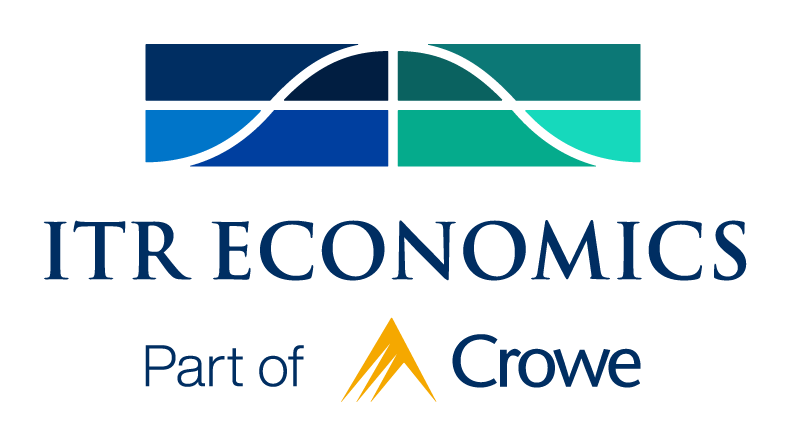October 7, 2024
- Home
- portfolio
- TrendsTalk
- October 7, 2024
IMPACT OF US DOMESTIC CORPORATE CASH HOLDINGS ON BUSINESSES
This week on TrendsTalk, ITR Economist Michael Feuz analyzes the latest US Domestic Corporate Cash Holdings data, as it is a leading indicator for B2B activity and new orders in numerous industries. With both positive and negative signs, what sort of impact will the data have on your business moving forward? Tune in to find out!

MEET YOUR HOST
Michael Feuz
Michael Feuz is a key member of ITR Economics’ team of expert economists and consultants. Backed by a decade of experience working for technology start-ups, he contributes to the production of client reports, forecast reviews, economic research, and regular client-facing communications.
“Join me on the TrendsTalk podcast to explore the world of economics. Episodes offer insightful discussion and expert interviews. We cover relevant economic concepts in an accessible way. Whether you are a curious layperson or an industry professional, TrendsTalk is your go-to source for thought-provoking analysis and a deeper understanding of the economic forces shaping our world.”
Key Episode Takeaways
- 0:10 – Introduction
- 1:25 – US Domestic Corporate Cash Holdings data
- 3:04 – Total Corporate Cash Holdings data for the US manufacturing industry
- 4:43 – Total Corporate Cash Holdings for the pharmaceuticals and medicines industry
- 5:51 – Impact of near-term tightening in corporate cash flow on businesses
The below transcript is a literal translation of the podcast audio that has been machine generated by Notta.
Michael Feuz:
Hello, everyone. I’m Michael Feuz, economist speaker here at ITR Economics. Welcome to another episode of TrendsTalk. I’m still filling in for Taylor St. Germain. But if you miss him, don’t worry. He’ll be back in the next few weeks.
Today, I want to build off last week’s TrendsTalk, where we discuss business-to-business activity in the US. We really looked at Non-Defense Capital Goods New Orders. We looked at how that B2B activity is slowing. And we tackled or looked at that series compared to four leading indicators that help paint a clearer picture and add robustness to our analysis.
Today, I want to focus on one of those four leading indicators taking an even deeper dive. And that’s US Domestic Corporate Cash Holdings. This series captures total cash on hand and in US banks. It includes corporations in manufacturing, mining, retail trade, wholesale trade, information, and professional and technical services.
So looking at it as broad as we can, total corporate cash holdings on a 12 MMA currently sits at $1.21 trillion. This is up roughly 44% since February 2020 level. Why am I talking about the February 2020 level over four years ago? That’s the time right before the world was turned upside down by the COVID-19 pandemic. So just trying to capture that pre-pandemic level. We’re well above that level. That’s a good thing. We’re at a very healthy level from a corporate cash perspective.
Now, we are seeing some near-term softening, though, in that US Domestic Corporate Cash Holdings. That 12 MMA that’s sitting at $1.21 trillion, that has declined the past three months. So we have data through June that I’m talking about today. And looking at the 3/12, that quarterly growth rate, it went below the zero line in April. And it has continued to decline and currently sits at negative 8.4% through June.
So that suggests or portends to further near-term cyclical decline in that 12/12. And it helps corroborate our outlook that we’re expecting further softness in new order trends across the macroeconomy. This will likely persist over the next several quarters as we round out 2024 and move into the early part of 2025.
Now, if we drill down a little farther into different industries, we do get a variety of trends. Let’s look first at the manufacturing industry. So Total Corporate Cash for US Manufacturing, it looks very similar to the total. On a 12 MMA, it, however, has been declining a little bit longer, really throughout 2024. But that 12/12 rate of change, that year-over-year growth, is still up 2.7% from a year ago today. Now that 3/12, which as I mentioned, always leads to the 12/12. That has dropped below the zero line and it sits very similarly at negative 8.3%. So again, corroborating and suggesting that 12/12 is gonna continue to just decline, potentially moving below the zero line.
Now, if we look at this Manufacturing Corporate Cash Holdings and use it as a leading indicator, we can compare it to US Machinery New Orders. Now, US Machinery New Orders, that sits at 0.3% on a 12/12 basis. We expect in our forecast further softening in this series over the next several quarters, the 12/12 to likely tick below the zero line to technically go into that phase D recession. The corporate cash corroborates that outlook as a leading indicator. But we do expect that 12/12, that decline in US Machinery New Orders to stay very close to that zero line. So you could maybe better describe it as just general softness, flatness in that growth rate.
Now, one that’s a little different, Total Corporate Cash for the Pharmaceuticals and Medicines Industry. This has recently transitioned into phase D recession. So on a 12/12 basis, it sits at negative 0.4%. So that’s below the zero line. And that 3/12 is well below the 12/12, suggesting further softness in this series. Now, looking at our outlook for Medical Equipment and Supply of Production, which is at 0.3% above the zero line year go levels. So still growth, we are expecting some mild contraction into the middle of next year. And now at the new orders for this space, US Electro-Medical Measuring and Controls Instrument New Orders. On a 12/12 basis, this is similarly in phase D, sitting at negative 0.4%. Looking at corporate cash, a little bit of softening, we should anticipate further near-term softness and new orders in the Medical Device and Equipment series.
Now, the data is suggesting there is some near-term tightening in cash for companies and organizations. You may be feeling this in your own business. When cash becomes tight, we anticipate logically that business investments will slow, be delayed farther out. We’ve been hearing this from our clients at ITR. Customers are taking longer to buy. They’re pushing out the larger orders. Even the smaller orders potentially have a longer approval process. So whether you’re evaluating your own strategic investments, what’s a must do right now, what can we wait on? Or you’re working with your customers to finalize potentially larger deals. There’s gonna be a greater need for a compelling ROI statement to justify these initiatives. Every dollar invested must justify its worth by delivering that strong return on investment.
I’m Michael Feuz, economist and speaker here at ITR Economics. Thank you for joining me on this episode of ITR TrendsTalk.





